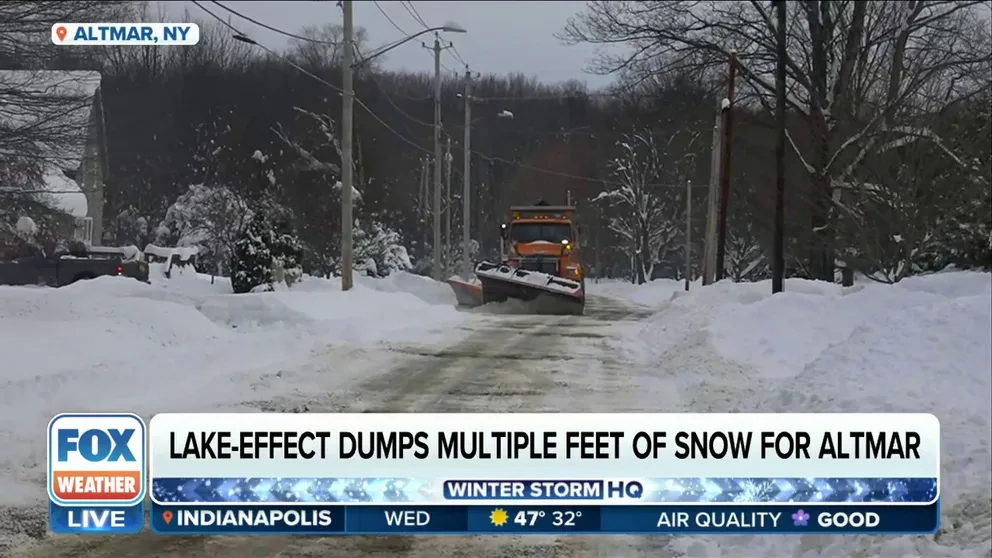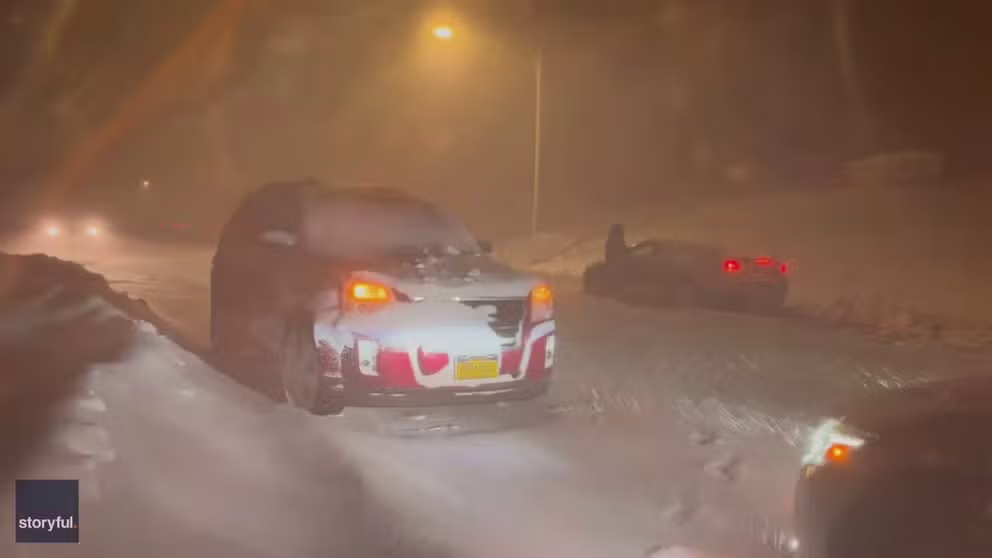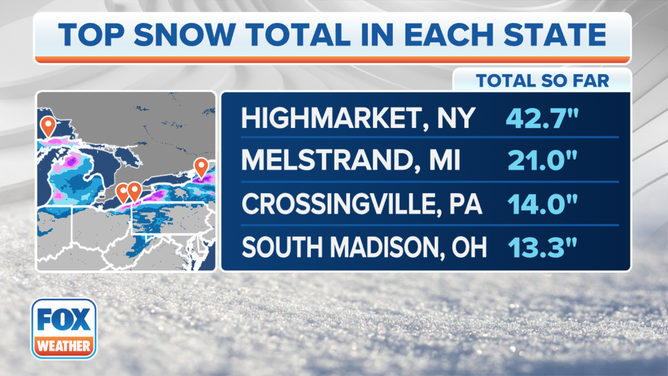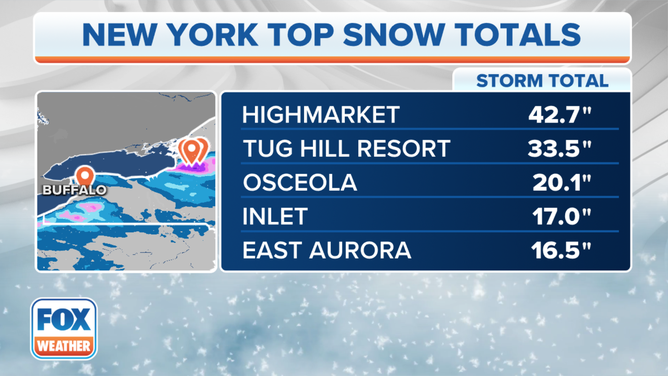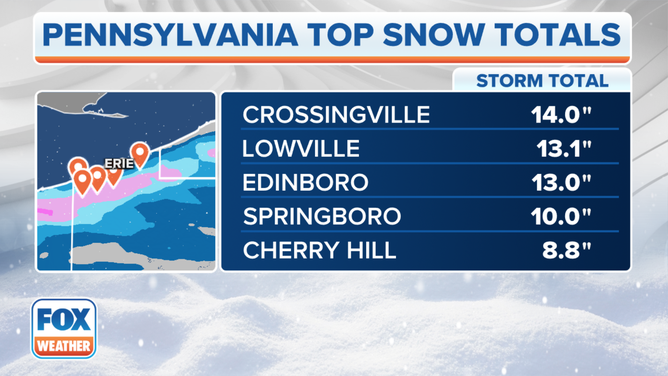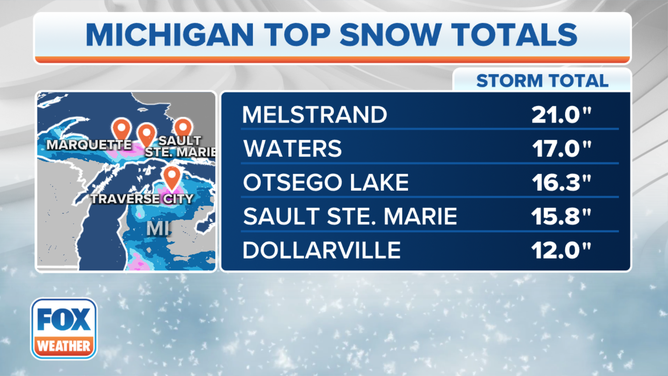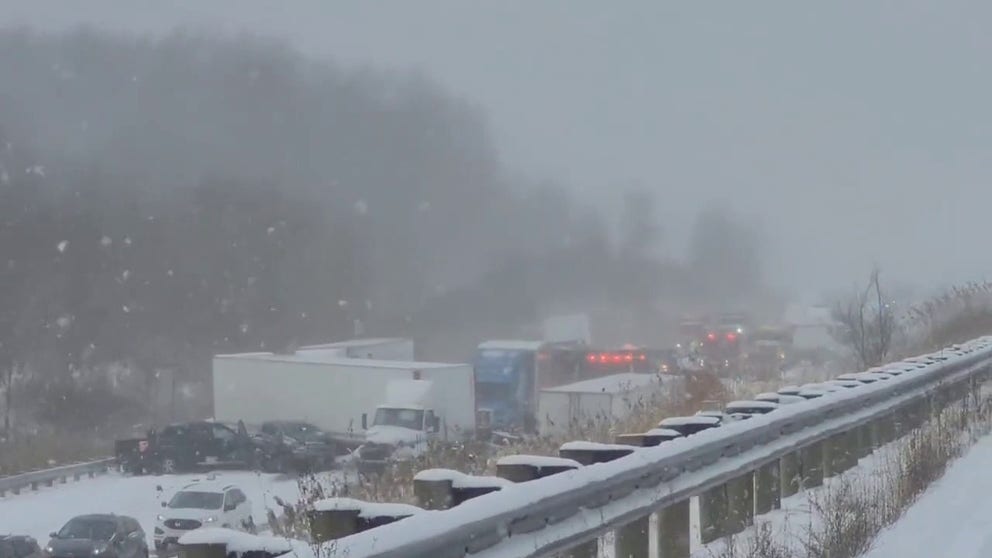Lake-effect snowstorm turns deadly in Pennsylvania after dumping more than 3.5 feet of snow in New York
More than 3.3 million Americans along the eastern shores of lakes Erie and Ontario in Ohio, Pennsylvania and New York state were under Lake-Effect Snow Warnings as the storm began to kick into high gear.
Cleanup underway after upstate New York gets buried under feet of snow
FOX Weather Multimedia Journalist Katie Byrne is in Altmar, New York, where the cleanup is underway after the region’s first significant lake-effect snowstorm of the season begins to wrap up.
KIDDER TOWNSHIP, Penn. – A man was killed in a crash on a snowy Pennsylvania interstate on Tuesday as the interior Northeast was being blasted by a lake-effect snowstorm that dumped more than 3.5 feet of snow in portions of New York state.
Pennsylvania State Police said a truck being driven by a 60-year-old man from Elizabeth, New Jersey, was traveling on Interstate 80 eastbound in Kidder Township, Pennsylvania, when it crashed off the right side of the road and slid down a steep embankment, where it hit several trees and rolled over onto its side.
Watch: Lake-effect snowstorm blasts New York with heavy snow
Video recorded in Hamburg, New York, shows vehicles pulled off to the side of the road as heavy snow falls during the region’s first major lake-effect snowstorm of the season on Monday, November 27, 2023.
The unidentified driver, who was the only person in the truck at the time, was pronounced dead at the scene.
In a release, Pennsylvania State Police said conditions were snowy and the roads were icy when the crash occurred Tuesday around 2:30 p.m. EST.
Watch: Snow causes near whiteout conditions in New York
Video recorded in West Turin, New York, shows near whiteout conditions as heavy lake-effect snow falls on Tuesday, Nov. 28, 2023.
The crash occurred as the Great Lakes and parts of the interior Northeast were being blasted by the first significant lake-effect snowstorm of the season, which dumped more than a foot of snow on four states – Michigan, New York, Ohio and Pennsylvania.
Additional snow was expected in parts of New York on Wednesday, but totals weren’t expected to amount to much before the storm comes to an end later in the day.
New York snow totals
The lake-effect snowstorm kicked into high gear Monday after cold air moved into the U.S. from Canada and swept across the still-unfrozen Great Lakes.
This led to the multiday winter weather event, which dumped more than a foot of snow across three states, including New York, which saw the highest snowfall total by far from this storm system.
As of Wednesday morning, Highmarket, New York, recorded a whopping 42.7 inches – more than 3.5 feet – of snow since the lake-effect snowstorm began.
Behind that, Redfield picked up just under 2 feet of snow.
Crossingville, Lowville and Edinboro in Pennsylvania all picked up more than a foot of snow. In Ohio, South Madison and Jefferson also saw more than a foot from this storm system.
Lake-Effect snowstorm leads to travel troubles in U.S., Canada
Watch: Multiple vehicles involved in pileup on snowy Ohio highway
Video recorded on Tuesday shows several vehicles involved in a crash on Interstate 271 near Richfield, Ohio, due to snow squalls.
Before the storm began, New York Gov. Kathy Hochul was urging New Yorkers to make preparations for the storm and pay attention to the forecast due to the shifting snow bands that were streaming off the Great Lakes.
"The most hazardous weather conditions will be in the areas where the lake-effect snow bands form and produce a lot of snow in a short period, which will hamper travel in some places for the next say or so," she had said in a statement.
Several crashes were reported on New York roads, including Interstate 90, because of the conditions.
New York State Police said several tractor-trailers slid off the highway in Rensselaer County, just southeast of Albany. Drivers were then asked to seek alternate routes until conditions improved.
In Ohio, a massive, 20-vehicle pileup was reported about 20 miles south of Cleveland near Richfield, Ohio. Video from the area showed several vehicles involved in the crash on Interstate 271.
The video showed several first responders at the scene while heavy snow was still falling.
Canada was also affected by the lake-effect snowstorm.
The Ontario Provincial Police (OPP) said on X, formerly Twitter, that they responded to several crashes outside of the Toronto area due to the whiteout conditions.
Highway 403 was closed due to a seven-vehicle crash and a three-vehicle crash, and at least four tractor-trailers were jackknifed in the area. OPP said a 36-year-old man was hospitalized with serious injuries after a crash.
Thundersnow reported along the Great Lakes
The FOX Forecast Center says thundersnow has also been observed near the lakeshores.
Thundersnow occurs when warm air is pulled into a snowstorm and causes the atmosphere to become more convective and unstable. The system can then produce lightning, similar to thunderstorms that occur during the spring and summer.
It's also important to note that while it may be exciting to see lightning and hear thunder during a snowstorm, it's still just as dangerous as it would be during severe weather.
